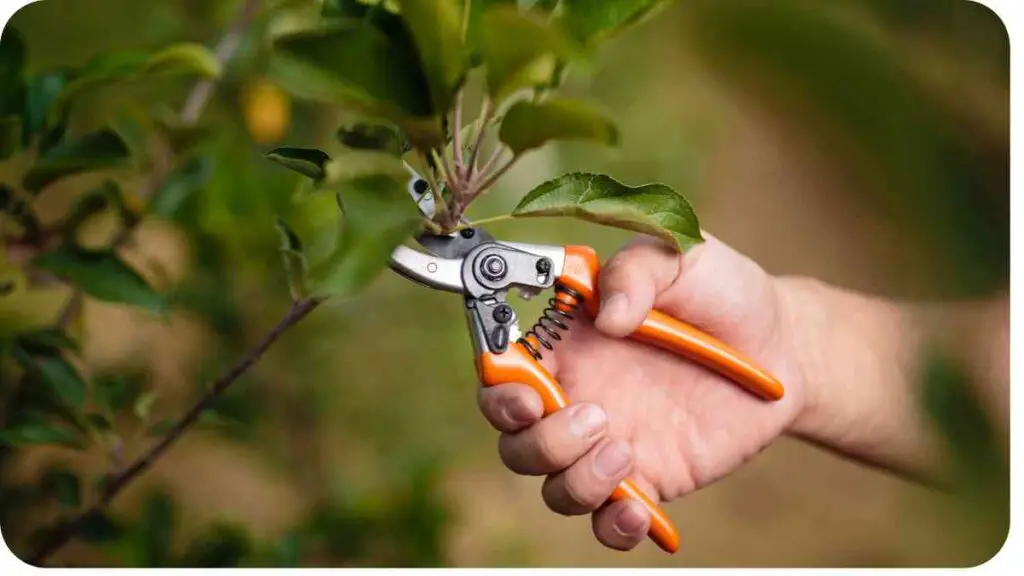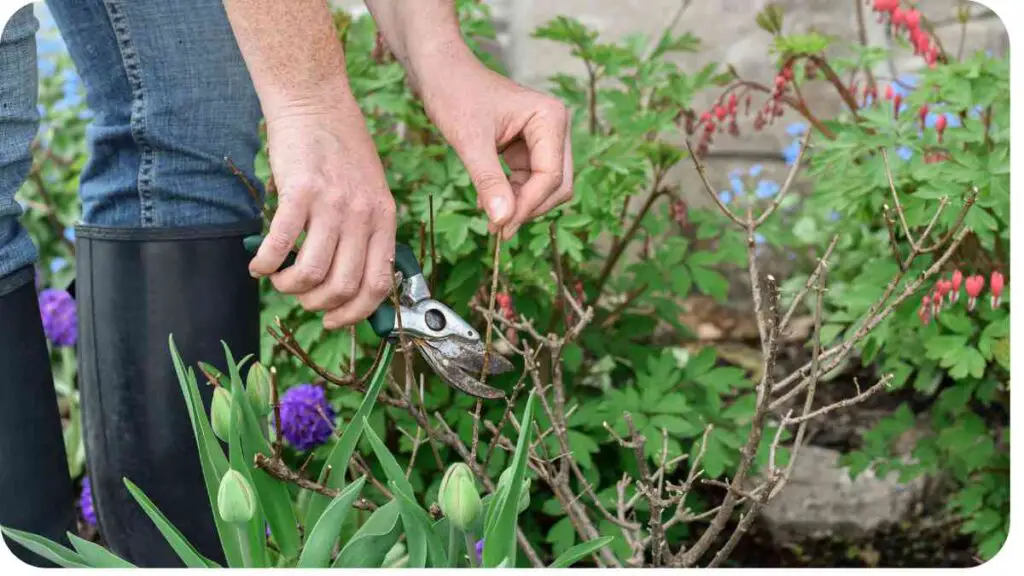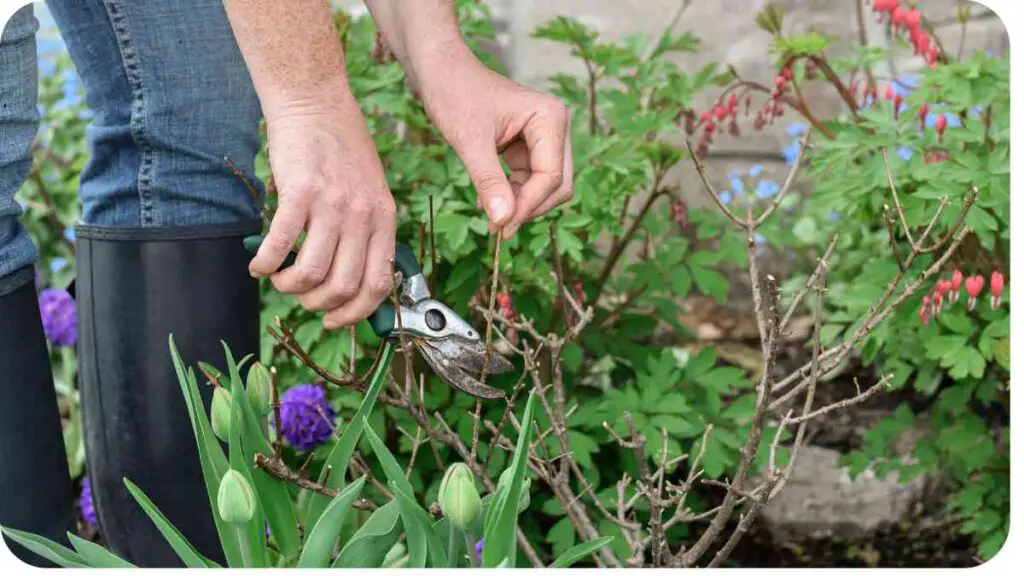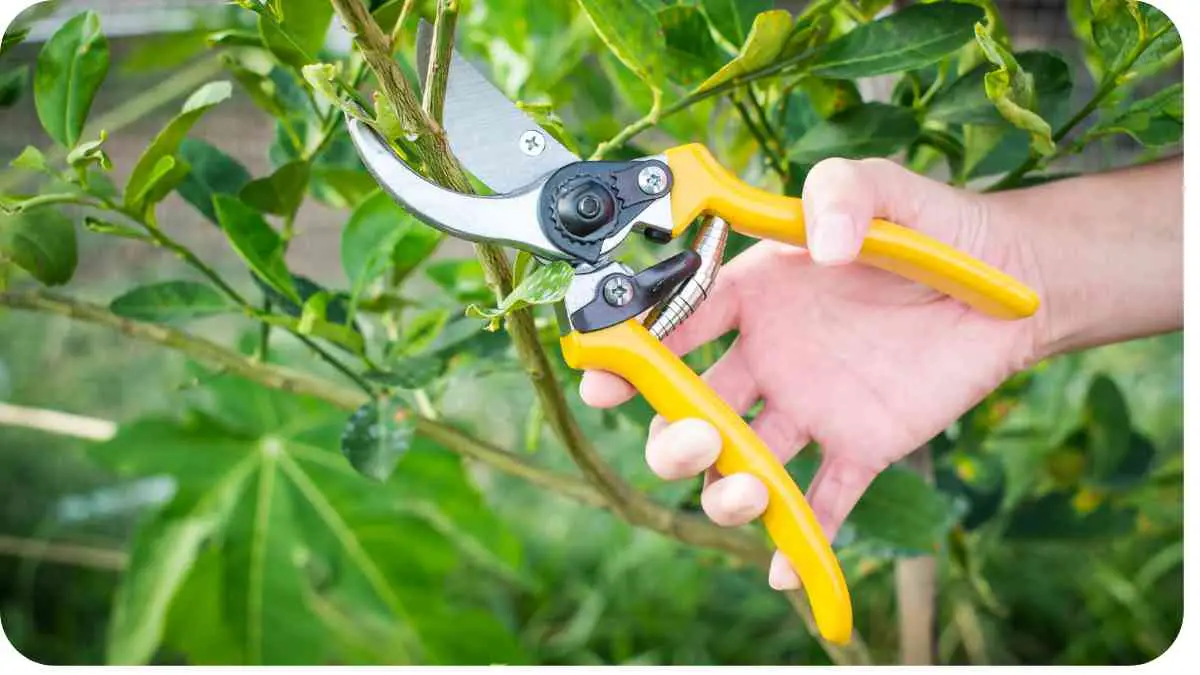Pruning is not just about snipping off branches; it’s a strategic technique that can supercharge the growth and health of your plants. In this comprehensive guide, we’ll delve into the art and science of pruning, exploring its benefits, techniques, tools, and best practices.
Whether you’re a novice gardener or a seasoned horticulturist, understanding the principles of pruning can transform your green spaces into flourishing landscapes.
| Key Takeaways |
|---|
| Proper pruning can unlock the full potential of your yard. |
| Pruning promotes healthy growth and reduces the risk of damage. |
| Understanding the specific needs of different plants is crucial for successful pruning. |
| Regular maintenance and observation are essential for ongoing pruning success. |
| When in doubt, consult a professional arborist for guidance and assistance. |
2. Understanding the Concept of Pruning

What is Pruning?
Pruning involves selectively removing parts of a plant to promote healthier growth, better fruit production, and aesthetic appeal. By cutting away dead or overgrown branches, you encourage the plant to allocate resources more efficiently, resulting in stronger stems, increased flower or fruit production, and improved overall vitality.
Understanding the intricate process of tree branching is essential for gardeners. As trees grow, they possess an innate ability to determine when to start branching out, influencing their overall structure and growth pattern.” How Do Trees Know When to Start Branching Out as They Grow? Pruning techniques can leverage this natural process for optimal results.
Table 1: Benefits of Pruning
| Benefits | Description |
|---|---|
| Stimulates Growth | Encourages new growth by redirecting resources to healthier branches. |
| Improves Air Circulation | Thinning out dense foliage allows air to flow more freely, reducing the risk of disease. |
| Enhances Aesthetic Appeal | Shapes the plant’s form, creating visually pleasing landscapes. |
| Increases Fruit Production | Removes excess branches to concentrate energy on fruit-bearing ones. |
| Prevents Disease | Eliminates diseased or dying branches, reducing the spread of pathogens. |
3. The Science Behind Pruning
Hormonal Impact
Pruning triggers hormonal responses within plants, influencing their growth patterns. When you make a cut, it stimulates the production of auxin, a hormone responsible for apical dominance. By removing the dominant shoot tip, you encourage lateral bud growth, resulting in bushier, more compact plants.
Resource Allocation
Plants have limited resources, including water, nutrients, and carbohydrates. Pruning helps optimize resource allocation by removing unnecessary or competing branches. This allows the plant to focus its energy on essential functions such as root development, flower production, and defense against pests and diseases.
Pruning is a key practice in gardening, and its benefits extend beyond mere aesthetics. Trimming plants stimulates growth by redirecting energy to essential areas, resulting in stronger, healthier foliage and blooms.” Why Does Trimming Plants Make Them Grow Stronger? Proper pruning techniques can maximize this growth-promoting effect.
4. Types of Pruning Techniques

Heading Cuts
Heading cuts involve removing a portion of a branch, typically by cutting just above a bud or lateral branch. This technique stimulates branching and encourages denser growth. It’s commonly used to shape shrubs and trees and to control their size.
Table 2: Types of Pruning Techniques
| Technique | Description |
|---|---|
| Heading Cuts | Removes a portion of a branch to stimulate branching and denser growth. Commonly used for shaping and controlling the size of shrubs and trees. |
| Thinning Cuts | Removes entire branches back to their point of origin, reducing density and improving air circulation within the plant canopy. Ideal for maintaining an open, airy structure. |
| Pinching | Involves using fingers or pruners to pinch off the tips of new growth, promoting branching and compact growth. Often used for shaping and controlling the size of herbaceous plants. |
| Shearing | Involves using hedge shears to trim the outer foliage of plants into specific shapes or forms. Commonly used for formal hedges and topiaries. |
5. Pruning for Different Plants
Trees
Pruning trees is essential for maintaining their health, safety, and aesthetics. Removing dead or diseased branches can prevent the spread of pathogens and reduce the risk of falling limbs. Additionally, pruning can shape the tree’s canopy, improve air circulation, and promote fruit production in fruit-bearing varieties.
Shrubs
Shrubs benefit from regular pruning to maintain their shape, encourage flowering, and prevent overcrowding. Thinning cuts are particularly useful for shrubs, as they open up the plant canopy, allowing sunlight to reach inner branches and promoting overall health and vigor.
Bonsai trees are marvels of nature, with their ability to thrive for centuries in tiny pots captivating enthusiasts worldwide. The secret to their longevity lies in meticulous cultivation techniques that balance root growth, pruning, and environmental factors.” What’s the Secret to Bonsai’s Centuries-Old Longevity in Tiny Pots? Mastering these techniques ensures bonsai trees flourish for generations.
Vines
Pruning vines is crucial for controlling their growth and maximizing flowering or fruiting. Training vines along trellises or fences and selectively pruning them can help maintain a tidy appearance and prevent them from becoming invasive.
Perennials
Perennials, including herbaceous plants and ornamental grasses, also benefit from occasional pruning. Removing spent flowers or dead foliage can prolong the plant’s blooming period and prevent self-seeding. Additionally, pruning can rejuvenate overgrown perennials and promote new growth.
6. When to Prune
Seasonal Timing
The timing of pruning depends on the plant species and its growth habits. In general, dormant pruning is best conducted during late winter or early spring before new growth begins. This allows the plant to heal quickly and reduces the risk of disease transmission.
Plant Growth Stage
Pruning should also consider the plant’s growth stage. Avoid pruning newly planted or stressed plants, as they need time to establish their root systems. Instead, focus on established plants during their dormant period or after flowering to minimize stress and maximize results.
7. Tools for Pruning
Hand Pruners
Hand pruners, also known as secateurs, are essential tools for precision pruning of small branches and stems. Choose bypass pruners for clean cuts on live branches and anvil pruners for deadwood or thicker stems.
The phenomenon of wrinkling fingers and toes in water has intrigued scientists for years. This natural response, known as vasoconstriction, occurs as the body adjusts to prolonged water exposure, enhancing grip and dexterity.” Why Do Fingers and Toes Wrinkle in Water? Understanding this process sheds light on the body’s adaptive mechanisms.
Loppers
Loppers are designed for cutting larger branches that hand pruners cannot handle. They feature long handles and heavy-duty blades, making them ideal for reaching higher branches and applying more leverage.
Pruning Saws
Pruning saws are necessary for cutting thick branches or tough woody growth. Choose a saw with a curved blade for easier cutting and a comfortable grip for extended use.
Hedge Shears
Hedge shears are used for shaping and trimming hedges, topiaries, and dense shrubs. They feature long blades with serrated edges for precise cutting and ergonomic handles for comfort during prolonged use.
8. Techniques for Pruning Success

Proper Cuts
When making cuts, it’s essential to use sharp, clean tools and make precise cuts at the correct angle. Avoid leaving stubs, as they can attract pests and pathogens. Instead, cut just above a bud or lateral branch to encourage new growth in the desired direction.
Cleaning and Sharpening Tools
Regularly clean and sharpen your pruning tools to maintain their effectiveness and prolong their lifespan. Disinfect tools between cuts, especially when working with diseased plants, to prevent the spread of pathogens.
Safety Precautions
Always wear appropriate safety gear, including gloves, eye protection, and sturdy footwear, when pruning. Be mindful of your surroundings and watch out for hazards such as uneven terrain, overhead power lines, or nearby structures.
9. Common Pruning Mistakes to Avoid
Over-Pruning
Over-pruning can weaken plants and disrupt their natural growth patterns. Avoid removing more than one-third of the plant’s foliage at a time and refrain from excessive shaping or thinning, especially during the growing season.
Improper Timing
Pruning at the wrong time can stress plants and interfere with their blooming or fruiting cycles. Research the specific pruning requirements of each plant species and prune accordingly to maximize results and minimize negative impacts.
Bonsai cultivation is an art form requiring patience, skill, and a deep understanding of horticulture. By carefully controlling factors such as root pruning, watering, and shaping, bonsai enthusiasts can transform ordinary trees into miniature wonders that captivate the imagination.” How Are Bonsai Trees Cultivated to Become Miniature Wonders? Delving into bonsai cultivation techniques unveils the magic behind these extraordinary creations.
Neglecting to Sterilize Tools
Failure to sterilize pruning tools between cuts can spread diseases from one plant to another. Use a solution of bleach or rubbing alcohol to disinfect tools, especially when working with diseased or infested plants.
10. Practical Tips for Pruning Like a Pro
Observe the Plant’s Natural Growth Pattern
Before pruning, take the time to observe the plant’s natural growth pattern and identify areas that need attention. Focus on removing dead, damaged, or crossing branches while preserving the plant’s overall form and structure.
Begin with Dead or Diseased Branches
Start pruning by removing dead, diseased, or damaged branches to improve the plant’s health and appearance. This initial step can also help you assess the plant’s overall condition and identify any additional pruning needs.
Take Your Time and Step Back to Assess
Pruning is a gradual process that requires patience and careful consideration. Take breaks as needed and step back periodically to assess your progress and ensure you’re achieving the desired results.
Don’t Hesitate to Seek Professional Help
If you’re unsure about how to prune a specific plant or if you encounter any challenges along the way, don’t hesitate to seek advice from a professional arborist or horticulturist. They can offer personalized guidance and ensure the best possible outcome for your plants.
11. Case Studies: Successful Pruning Stories
The Tale of the Overgrown Hedge
Sarah, a homeowner with a passion for gardening, faced a dilemma when her once-neat hedge started to overtake her front yard. Unsure of where to begin, she enlisted the help of a local landscaper who recommended a thorough pruning session. By carefully thinning out the dense foliage and shaping the hedge into a more manageable form, Sarah was able to reclaim her yard’s curb appeal and restore balance to her landscape.
Reviving the Neglected Fruit Tree
James, an avid orchardist, noticed that his apple tree was struggling to produce fruit despite receiving ample sunlight and water. Upon closer inspection, he discovered that the tree was overrun with deadwood and competing branches.
Armed with his pruning shears, James embarked on a pruning spree, removing deadwood and thinning out crowded branches to improve air circulation and sunlight penetration. The following season, his efforts paid off as the apple tree burst into bloom, yielding a bountiful harvest of juicy apples.
12. Conclusion
Pruning is a valuable skill that can transform your garden into a thriving oasis of beauty and productivity. By understanding the principles of pruning and following best practices, you can unleash the growth-boosting power of pruning and unlock the full potential of your plants.
Whether you’re shaping shrubs, training vines, or rejuvenating trees, the key is to approach pruning with care, patience, and a keen eye for detail. So grab your pruning shears and embark on a journey to cultivate healthier, happier plants—it’s time to unlock the magic of pruning!
Further Reading
- How to Prune a Tree: Unlock Your Yard’s Full Potential: Learn the essential techniques for tree pruning and discover how it can enhance the beauty and health of your yard.
- Benefits of Tree Pruning: Explore the numerous advantages of tree pruning, from promoting healthy growth to reducing the risk of storm damage.
- Pruning African Coral Tree: A Comprehensive Guide: Dive into the specifics of pruning African coral trees and unleash their full ornamental potential in your landscape.
FAQs
How often should I prune my trees?
Pruning frequency depends on factors such as tree species, age, and growth rate. In general, it’s recommended to prune deciduous trees every 3-5 years and evergreen trees every 5-7 years to maintain their health and shape.
When is the best time to prune trees?
The ideal time to prune trees varies depending on the species and climate. However, dormant pruning during late winter or early spring is generally preferred, as it minimizes stress on the tree and reduces the risk of disease transmission.
Can I prune my trees myself, or should I hire a professional?
While some minor pruning tasks can be done by homeowners, it’s advisable to hire a certified arborist for more extensive pruning work or if you’re unsure about the proper techniques. Professionals have the expertise and equipment to ensure the job is done safely and effectively.
How much should I prune off my trees?
When pruning trees, the goal is to remove dead, diseased, or crossing branches while preserving the tree’s natural form and structure. As a general rule, avoid removing more than 25% of the tree’s foliage in a single pruning session to prevent stress and promote healthy regrowth.
What are the signs that a tree needs pruning?
Common signs that a tree requires pruning include dead or diseased branches, crossing or rubbing branches, excessive canopy density, and signs of structural weakness such as cracks or splits in the trunk or branches. Regular inspection can help identify pruning needs before they become problematic.

For 15 years, Hellen James has worked in the gardening industry as an expert and landscape designer. During her career, she has worked for a variety of businesses that specialize in landscaping and gardening from small firms to large corporations.

